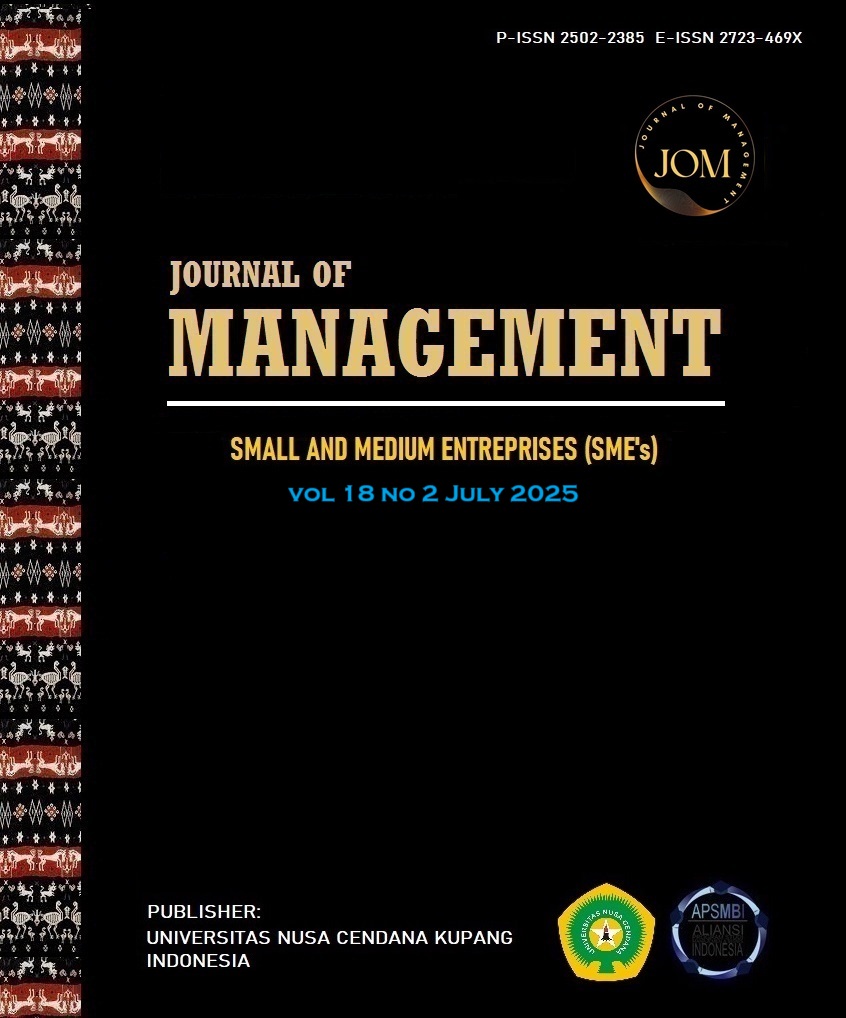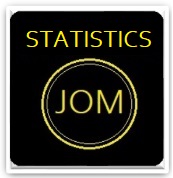WHAT DRIVES CAPITAL STRUCTURE ? EVIDENCE FROM MANUFACTURING FIRMS IN INDONESIA
Abstract
This study investigates the impact of profitability, liquidity, growth opportunity, and asset tangibility on the capital structure of manufacturing firms in Indonesia. This study employs the pecking order theory to examine data from 140 manufacturing companies listed on the Indonesia Stock Exchange from 2017 to 2024. The companies were chosen based on criteria such as having full financial statements, being listed before 2017, and not having negative equity. A total of 1,120 firm-year observations were analyzed using panel data regression with STATA. The findings indicate that profitability and liquidity have a significant negative impact on capital structure, while asset tangibility has a significant positive effect. However, growth opportunity does not have a significant effect, suggesting that expansion potential is not a primary factor in determining debt utilization among manufacturing firms. These findings support the pecking order theory and emphasize the importance of internal financial strength and asset structure in financing decisions. Companies are encouraged to maintain strong internal funding capabilities and manage debt prudently to ensure financial sustainability.
Keywords: Capital Structure; Profitability; Liquidity; Growth Opportunity ; Asset Tangibility ; Manufacturing Sector
Downloads
References
Amin, M., Rahman, M., & Hossain, M. (2023). Growth opportunity and capital structure decisions: Evidence from emerging markets. Journal of Asian Finance, Economics and Business, 10(2), 45–54.
Anggraini, R., Putri, D. E., & Susanti, R. (2020). The effect of liquidity, profitability, and asset structure on capital structure. Jurnal Akuntansi, 24(2), 217–232.
Asmanto, & Andayani, W. (2020). Growth opportunity and firm value: Empirical evidence from Indonesia. Jurnal Ilmiah Akuntansi dan Bisnis, 15(1), 24–34.
Baltagi, B. H. (2005). Econometric analysis of panel data (3rd ed.). John Wiley & Sons.
Brealey, R. A., Myers, S. C., & Allen, F. (2020). Principles of corporate finance (13th ed.). McGraw-Hill Education.
Brigham, E. F., & Ehrhardt, M. C. (2017). Financial management: Theory & practice (15th ed.). Cengage Learning.
Brigham, E. F., & Houston, J. F. (2014). Fundamentals of financial management (14th ed.). Cengage Learning.
Buana, Y. P., Pratama, M. F., & Sari, N. P. (2024). The impact of liquidity and profitability on capital structure: Evidence from Indonesian manufacturing firms. Jurnal Keuangan dan Perbankan, 28(1), 112–124.
Campello, M., Graham, J. R., & Harvey, C. R. (2010). The real effects of financial constraints: Evidence from a financial crisis. Journal of Financial Economics, 97(3), 470–487.
Deesomsak, R., Paudyal, K., & Pescetto, G. (2004). The determinants of capital structure: Evidence from the Asia Pacific region. Journal of Multinational Financial Management, 14(4–5), 387–405.
Dewi, M. A. P., & Lestari, P. V. (2014). Pengaruh struktur modal, profitabilitas, dan ukuran perusahaan terhadap nilai perusahaan pada perusahaan manufaktur. E-Jurnal Manajemen Universitas Udayana, 3(6), 1561–1575.
Fachri, M., & Adiyanto, D. (2019). The effect of growth opportunity and profitability on capital structure. Jurnal Ilmiah Ekonomi dan Bisnis, 16(2), 178–185.
Fitriany, R., & Nuraini, R. (2016). Growth opportunity and capital structure: Evidence from Indonesian manufacturing firms. Jurnal Riset Akuntansi dan Keuangan, 4(1), 87–100.
Frank, M. Z., & Goyal, V. K. (2003). Testing the pecking order theory of capital structure. Journal of Financial Economics, 67(2), 217–248.
Frank, M. Z., & Goyal, V. K. (2009). Capital structure decisions: Which factors are reliably important? Financial Management, 38(1), 1–37.
Ghosh, S. (2012). Firm growth, financial structure and productivity: Evidence from Indian manufacturing. Journal of Industry, Competition and Trade, 12(3), 253–278.
Gujarati, D. N., & Porter, D. C. (2009). Basic econometrics (5th ed.). McGraw-Hill Education.
Hair, J. F., Black, W. C., Babin, B. J., & Anderson, R. E. (2019). Multivariate data analysis (8th ed.). Cengage Learning.
Harris, M., & Raviv, A. (1991). The theory of capital structure. Journal of Finance, 46(1), 297–355.
Hery. (2015). Analisis laporan keuangan. CAPS.
Hussain, H. I., & Miras, H. (2015). The relationship between capital structure and firm performance: Evidence from Malaysia. International Journal of Economics and Financial Issues, 5(2), 387–398.
Kasmir. (2015). Analisis laporan keuangan. PT RajaGrafindo Persada.
Kayo, E. K., & Kimura, H. (2011). Hierarchical determinants of capital structure. Journal of Banking & Finance, 35(2), 358–371.
Kjellman, A., & Hansen, S. (1995). Determinants of capital structure: Theory vs. practice. Scandinavian Journal of Management, 11(2), 91–102.
Kurniasih, E. (2021). Manajemen struktur modal: Strategi optimalisasi kinerja perusahaan. Jurnal Manajemen dan Organisasi, 12(1), 45–58.
Moradi, A., & Paulet, E. (2019). The firm-specific determinants of capital structure – An empirical analysis of firms before and during the Euro Crisis. Research in International Business and Finance, 47, 150–161.
Myers, S. C. (1977). Determinants of corporate borrowing. Journal of Financial Economics, 5(2), 147–175.
Myers, S. C., & Majluf, N. S. (1984). Corporate financing and investment decisions when firms have information that investors do not have. Journal of Financial Economics, 13(2), 187–221.
Naibaho, M., & Kristanti, F. T. (2024). Firm-specific factors and capital structure: Evidence from Indonesia. Jurnal Keuangan dan Perbankan, 28(1), 35–49.
Nisfianti, F., & Handayani, R. (2017). Pengaruh profitabilitas, struktur aktiva, dan pertumbuhan penjualan terhadap struktur modal. Jurnal Ekonomi dan Bisnis, 20(2), 150–162.
Nohong, M. (2016). Manajemen keuangan perusahaan. Penerbit Andi.
Park, C., Kim, H., & Lee, D. (2024). Financial performance and capital structure during economic uncertainty: Evidence from the COVID-19 pandemic. Finance Research Letters, 59, 104215.
Prakash, A. (2023). The cost of debt during the COVID-19 pandemic: Evidence from emerging markets. Journal of Emerging Market Finance, 22(1), 23–45.
Putri, F. N., & Basuki, B. (2020). The effect of profitability, liquidity, asset structure, and firm size on capital structure. Jurnal Ilmiah Akuntansi dan Bisnis, 15(1), 45–58.
Rahmawati, S., & Handayani, R. (2023). COVID-19 impact on firm performance in Indonesia: Evidence from manufacturing. Jurnal Akuntansi dan Keuangan, 25(3), 201–218.
Rajan, R. G., & Zingales, L. (1995). What do we know about capital structure? Some evidence from international data. Journal of Finance, 50(5), 1421–1460.
Rajput, N., & Jhunjhunwala, S. (2019). Pecking order theory and capital structure: Evidence from Indian manufacturing firms. Indian Journal of Finance, 13(5), 9–24.
Ross, S. A., Westerfield, R. W., & Jordan, B. D. (2016). Fundamentals of corporate finance (11th ed.). McGraw-Hill Education.
Rus, R., Hashim, H. A., & Ariff, A. M. (2019). Capital structure determinants of Shariah-compliant and non-Shariah-compliant firms in Malaysia. International Journal of Islamic and Middle Eastern Finance and Management, 12(2), 282–298.
Saif-Alyousfi, A. Y. H., Md-Rus, R., & Taib, H. M. (2020). Capital structure determinants of listed firms in Malaysia. Journal of Economic Studies, 47(3), 575–603.
Seftianne, & Handayani, R. (2011). Factors affecting capital structure in public companies listed on the Indonesia Stock Exchange. Jurnal Bisnis dan Akuntansi, 13(1), 39–56.
Sharif, A., Aloui, C., & Yarovaya, L. (2020). COVID-19 pandemic, oil prices, stock market, geopolitical risk and policy uncertainty nexus in the US economy: Fresh evidence from the wavelet-based approach. International Review of Financial Analysis, 70, 101496.
Titman, S., & Wessels, R. (1988). The determinants of capital structure choice. Journal of Finance, 43(1), 1–19.
Titman, S., Wei, K. C. J., & Xie, F. (2017). Market development and the asset growth effect: International evidence. Journal of Financial and Quantitative Analysis, 52(5), 2119–2146.
Widodo, E., & Juardi, R. (2020). Asset tangibility and leverage: Evidence from Indonesia. Jurnal Ekonomi dan Pembangunan, 28(1), 15–26.
Wijaya, L., & Lesmana, R. (2020). The impact of COVID-19 on capital structure decisions: Evidence from Indonesia. Jurnal Keuangan dan Perbankan, 24(3), 305–318.
Wooldridge, J. M. (2013). Introductory econometrics: A modern approach (5th ed.). South-Western Cengage Learning.
World Bank. (2021). Indonesia economic prospects: Boosting the recovery. World Bank Group.

 Mariana Ing Malelak(1*)
Mariana Ing Malelak(1*)



